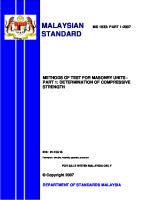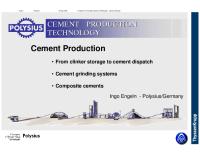Compressive Strength of Hydraulic Cement Mortars (Using 2-In. or (50-mm) Cube Specimens) [PDF]
Designation: C109/C109M − 16a Standard Test Method for Compressive Strength of Hydraulic Cement Mortars (Using 2-in. o
37 0 151KB
Papiere empfehlen
![Compressive Strength of Hydraulic Cement Mortars (Using 2-In. or (50-mm) Cube Specimens) [PDF]](https://vdoc.tips/img/200x200/compressive-strength-of-hydraulic-cement-mortars-using-2-in-or-50-mm-cube-specimens.jpg)
- Author / Uploaded
- anant11235
Datei wird geladen, bitte warten...
Zitiervorschau
Designation: C109/C109M − 16a
Standard Test Method for
Compressive Strength of Hydraulic Cement Mortars (Using 2-in. or [50-mm] Cube Specimens)1 This standard is issued under the fixed designation C109/C109M; the number immediately following the designation indicates the year of original adoption or, in the case of revision, the year of last revision. A number in parentheses indicates the year of last reapproval. A superscript epsilon (´) indicates an editorial change since the last revision or reapproval. This standard has been approved for use by agencies of the U.S. Department of Defense.
1. Scope* 1.1 This test method covers determination of the compressive strength of hydraulic cement mortars, using 2-in. or [50-mm] cube specimens. NOTE 1—Test Method C349 provides an alternative procedure for this determination (not to be used for acceptance tests).
1.2 This test method covers the application of the test using either inch-pound or SI units. The values stated in either SI units or inch-pound units are to be regarded separately as standard. Within the text, the SI units are shown in brackets. The values stated in each system may not be exact equivalents; therefore, each system shall be used independently of the other. Combining values from the two systems may result in nonconformance with the standard. 1.3 Values in SI units shall be obtained by measurement in SI units or by appropriate conversion, using the Rules for Conversion and Rounding given in IEEE/ASTM SI-10, of measurements made in other units. 1.4 This standard does not purport to address all of the safety concerns, if any, associated with its use. It is the responsibility of the user of this standard to establish appropriate safety and health practices and determine the applicability of regulatory limitations prior to use. (Warning—Fresh hydraulic cementitious mixtures are caustic and may cause chemical burns to skin and tissue upon prolonged exposure.2) 2. Referenced Documents 2.1 ASTM Standards:3 C91 Specification for Masonry Cement
1 This test method is under the jurisdiction of ASTM Committee C01 on Cement and is the direct responsibility of Subcommittee C01.27 on Strength. Current edition approved March 1, 2016. Published April 2016. Originally approved in 1934. Last previous edition approved in 2016 as C109/C109M – 16. DOI: 10.1520/C0109_C0109M-16A. 2 See the section on Safety, Manual of Cement Testing, Annual Book of ASTM Standards, Vol 04.01. 3 For referenced ASTM standards, visit the ASTM website, www.astm.org, or contact ASTM Customer Service at [email protected]. For Annual Book of ASTM Standards volume information, refer to the standard’s Document Summary page on the ASTM website.
C114 Test Methods for Chemical Analysis of Hydraulic Cement C150 Specification for Portland Cement C230/C230M Specification for Flow Table for Use in Tests of Hydraulic Cement C305 Practice for Mechanical Mixing of Hydraulic Cement Pastes and Mortars of Plastic Consistency C349 Test Method for Compressive Strength of HydraulicCement Mortars (Using Portions of Prisms Broken in Flexure) C511 Specification for Mixing Rooms, Moist Cabinets, Moist Rooms, and Water Storage Tanks Used in the Testing of Hydraulic Cements and Concretes C595 Specification for Blended Hydraulic Cements C618 Specification for Coal Fly Ash and Raw or Calcined Natural Pozzolan for Use in Concrete C670 Practice for Preparing Precision and Bias Statements for Test Methods for Construction Materials C778 Specification for Standard Sand C989 Specification for Slag Cement for Use in Concrete and Mortars C1005 Specification for Reference Masses and Devices for Determining Mass and Volume for Use in the Physical Testing of Hydraulic Cements C1157 Performance Specification for Hydraulic Cement C1328 Specification for Plastic (Stucco) Cement C1329 Specification for Mortar Cement C1437 Test Method for Flow of Hydraulic Cement Mortar E4 Practices for Force Verification of Testing Machines 2.2 IEEE/ASTM Standard:3 IEEE/ASTM SI-10 Standard for Use of the International System of Units (SI): The Modern Metric System 3. Summary of Test Method 3.1 The mortar used consists of 1 part cement and 2.75 parts of sand proportioned by mass. Portland or air-entraining portland cements are mixed at specified water/cement ratios. Water content for other cements is that sufficient to obtain a flow of 110 6 5 in 25 drops of the flow table. Two-inch or [50-mm] test cubes are compacted by tamping in two layers.
*A Summary of Changes section appears at the end of this standard Copyright © ASTM International, 100 Barr Harbor Drive, PO Box C700, West Conshohocken, PA 19428-2959. United States
Copyright by ASTM Int'l (all rights reserved); Wed Oct 12 03:23:41 EDT 2016 1 Downloaded/printed by National Institute of Technology - Suratkal - Karnatka (National Institute of Technology - Suratkal - Karnatka) pursuant to License Agreement. No further reproductions authorized.
C109/C109M − 16a The cubes are cured one day in the molds and stripped and immersed in lime water until tested. 4. Significance and Use 4.1 This test method provides a means of determining the compressive strength of hydraulic cement and other mortars and results may be used to determine compliance with specifications. Further, this test method is referenced by numerous other specifications and test methods. Caution must be exercised in using the results of this test method to predict the strength of concretes. 5. Apparatus 5.1 Weights and Weighing Devices, shall conform to the requirements of Specification C1005. The weighing device shall be evaluated for precision and accuracy at a total load of 2000 g. 5.2 Glass Graduates, of suitable capacities (preferably large enough to measure the mixing water in a single operation) to deliver the indicated volume at 20°C. The permissible variation shall be 62 mL. These graduates shall be subdivided to at least 5 mL, except that the graduation lines may be omitted for the lowest 10 mL for a 250-mL graduate and for the lowest 25 mL of a 500-mL graduate. The main graduation lines shall be circles and shall be numbered. The least graduations shall extend at least one seventh of the way around, and intermediate graduations shall extend at least one fifth of the way around. 5.3 Specimen Molds, for the 2-in. or [50-mm] cube specimens shall be tight fitting. The molds shall have not more than three cube compartments and shall be separable into not more than two parts. The parts of the molds when assembled shall be positively held together. The molds shall be made of hard metal not attacked by the cement mortar. For new molds the Rockwell hardness number of the metal shall be not less than 55 HRB. The sides of the molds shall be sufficiently rigid to prevent spreading or warping. The interior faces of the molds shall be plane surfaces and shall conform to the tolerances of Table 1. 5.3.1 Cube molds shall be checked for conformance to the design and dimensional requirements of this test method at least every 2½ years. 5.4 Mixer, Bowl and Paddle, an electrically driven mechanical mixer of the type equipped with paddle and mixing bowl, as specified in Practice C305. 5.5 Flow Table and Flow Mold, conforming to the requirements of Specification C230/C230M.
5.6 Tamper, a nonabsorptive, nonabrasive, nonbrittle material such as a rubber compound having a Shore A durometer hardness of 80 6 10 or seasoned oak wood rendered nonabsorptive by immersion for 15 min in paraffin at approximately 392°F or [200°C], shall have a cross section of 0.5 (60.06) by 1-in (60.06) [13 (61.6) by 25 (61.6) mm] and a length of 5 to 6 in. or [120 to 150 mm]. The tamping face shall be flat and at right angles to the length of the tamper. 5.6.1 Tampers shall be checked for conformance to the design and dimensional requirements of this test method at least every six months. NOTE 2—Each day that the tamper is used a visual inspection should confirm that the end is flat and at a right angle to the long axis of the tamper. Rounded or peeling tampers should not be allowed for use.
5.7 Trowel, having a steel blade 4 to 6 in. [100 to 150 mm] in length, with straight edges. 5.8 Moist Cabinet or Room, conforming to the requirements of Specification C511. 5.9 Testing Machine, either the hydraulic or the screw type, with sufficient opening between the upper bearing surface and the lower bearing surface of the machine to permit the use of verifying apparatus. The load applied to the test specimen shall be indicated with an accuracy of 61.0 %. If the load applied by the compression machine is registered on a dial, the dial shall be provided with a graduated scale that can be read to at least the nearest 0.1 % of the full scale load (Note 3). The dial shall be readable within 1 % of the indicated load at any given load level within the loading range. In no case shall the loading range of a dial be considered to include loads below the value that is 100 times the smallest change of load that can be read on the scale. The scale shall be provided with a graduation line equal to zero and so numbered. The dial pointer shall be of sufficient length to reach the graduation marks; the width of the end of the pointer shall not exceed the clear distance between the smallest graduations. Each dial shall be equipped with a zero adjustment that is easily accessible from the outside of the dial case, and with a suitable device that at all times until reset, will indicate to within 1 % accuracy the maximum load applied to the specimen. 5.9.1 If the testing machine load is indicated in digital form, the numerical display must be large enough to be easily read. The numerical increment must be equal to or less than 0.10 % of the full scale load of a given loading range. In no case shall the verified loading range include loads less than the minimum numerical increment multiplied by 100. The accuracy of the indicated load must be within 1.0 % for any value displayed
TABLE 1 Permissible Variations of Specimen Molds Parameter Planeness of sides Distance between opposite sides Height of each compartment Angle between adjacent facesA
2-in. Cube Molds New In Use









